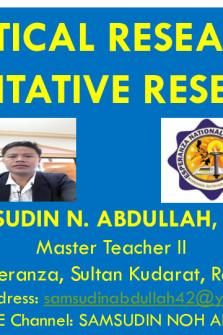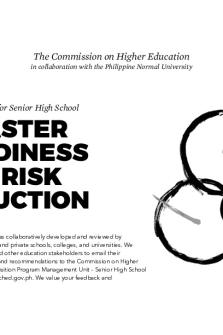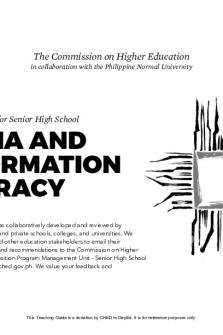Teaching Guide for Senior High School PDF

| Title | Teaching Guide for Senior High School |
|---|---|
| Author | Angela Llavore |
| Pages | 340 |
| File Size | 17.4 MB |
| File Type | |
| Total Downloads | 647 |
| Total Views | 1,023 |
Summary
The Commission on Higher Education in collaboration with the Philippine Normal University Teaching Guide for Senior High School BUSINESS FINANCE SPECIALIZED SUBJECT This Teaching Guide was collaboratively developed and reviewed by educators from public and private schools, colleges, and universities...
Description
Accelerat ing t he world's research.
Teaching Guide for Senior High School Angela Llavore
Related papers
Download a PDF Pack of t he best relat ed papers
The Commission on Higher Education in collaboration with the Philippine Normal University
Teaching Guide for Senior High School
BUSINESS FINANCE SPECIALIZED SUBJECT This Teaching Guide was collaboratively developed and reviewed by educators from public and private schools, colleges, and universities. We encourage teachers and other education stakeholders to email their feedback, comments, and recommendations to the Commission on Higher Education, K to 12 Transition Program Management Unit - Senior High School Support Team at [email protected]. We value your feedback and recommendations.
Development Team Team Leader: Arthur S. Cayanan, Ph.D. Writers: Jerelleen A. Rodriguez, Al-Habbyel B. Yusoph, Rachelleen A. Rodriguez, Diogenes C. Dy Technical Editors: Pamela Anne S. Lloren, Ma. Andrea Antonino-Balce Copyreader: Patricia Carmela I. Lumanlan Published by the Commission on Higher Education, 2016
Chairperson: Patricia B. Licuanan, Ph.D.
Illustrator: Patricia G. De Vera
Commission on Higher Education
K to 12 Transition Program Management Unit
Office Address: 4th Floor, Commission on Higher Education, C.P. Garcia Ave., Diliman, Quezon City
Telefax: (02) 441-0927 / E-mail Address: [email protected]
Senior High School Support Team
CHED K to 12 Transition Program Management Unit Program Director: Karol Mark R. Yee Lead for Senior High School Support:
Gerson M. Abesamis
Consultants THIS PROJECT WAS DEVELOPED WITH THE PHILIPPINE NORMAL UNIVERSITY.
University President: Ester B. Ogena, Ph.D.
VP for Academics: Ma. Antoinette C. Montealegre, Ph.D.
VP for University Relations & Advancement: Rosemarievic V. Diaz, Ph.D. Ma. Cynthia Rose B. Bautista, Ph.D., CHED
Bienvenido F. Nebres, S.J., Ph.D., Ateneo de Manila University
Carmela C. Oracion, Ph.D., Ateneo de Manila University
Minella C. Alarcon, Ph.D., CHED Gareth Price, Sheffield Hallam University
Stuart Bevins, Ph.D., Sheffield Hallam University
Course Development Officers:
John Carlo P. Fernando, Danie Son D. Gonzalvo, Stanley Ernest G. Yu Lead for Policy Advocacy and Communications:
Averill M. Pizarro Teacher Training Officers:
Ma. Theresa C. Carlos, Mylene E. Dones Monitoring and Evaluation Officer:
Robert Adrian N. Daulat Administrative Officers:
Ma. Leana Paula B. Bato, Kevin Ross D. Nera, Allison A. Danao, Ayhen Loisse B. Dalena Printed in the Philippines by EC-TEC Commercial, No. 32 St. Louis Compound 7, Baesa, Quezon City, [email protected]
This Teaching Guide by the Commission on Higher Education is licensed under a Creative Commons AttributionNonCommercial-ShareAlike 4.0 International License. This means you are free to: Share — copy and redistribute the material in any medium or format Adapt — remix, transform, and build upon the material. The licensor, CHED, cannot revoke these freedoms as long as you follow the license terms. However, under the following terms: Attribution — You must give appropriate credit, provide a link to the license, and indicate if changes were made. You may do so in any reasonable manner, but not in any way that suggests the licensor endorses you or your use. NonCommercial — You may not use the material for commercial purposes. ShareAlike — If you remix, transform, or build upon the material, you must distribute your contributions under the same license as the original.
Table of Contents Introduction to Financial Management
Part 3
170
184
Part 1
1
Part 4
Part 2
10
Sources and Uses of Short-Term and Long-Term Funds
Part 3
19
Part 1
Review of Financial Statement Preparation, Analysis, and Interpretation
Part 2
201
214
Part 1
37
Basic Long-term Financial Concepts
Part 2
54
Part 1
222
Part 3
60
Part 2
240
Part 4
68
Part 3
248
Part 5
76
Part 4
255
Part 6
87
Part 5
268
Part 7
94
Introduction to Investment
Part 8
99
Part 1
285
Part 2
300
Financial Planning Tools and Concepts Part 1
119
Managing Personal Finance
314
Part 2
139
Biographical Notes . . . . . . . . . . . . . . . . . . . . . . . . . . . . . . . . .
323
Introduction As the Commission supports DepEd’s implementation of Senior High School (SHS), it upholds the vision and mission of the K to 12 program, stated in Section 2 of Republic Act 10533, or the Enhanced Basic Education Act of 2013, that “every graduate of basic education be an empowered individual, through a program rooted on...the competence to engage in work and be productive, the ability to coexist in fruitful harmony with local and global communities, the capability to engage in creative and critical thinking, and the capacity and willingness to transform others and oneself.” To accomplish this, the Commission partnered with the Philippine Normal University (PNU), the National Center for Teacher Education, to develop Teaching Guides for Courses of SHS. Together with PNU, this Teaching Guide was studied and reviewed by education and pedagogy experts, and was enhanced with appropriate methodologies and strategies. Furthermore, the Commission believes that teachers are the most important partners in attaining this goal. Incorporated in this Teaching Guide is a framework that will guide them in creating lessons and assessment tools, support them in facilitating activities and questions, and assist them towards deeper content areas and competencies. Thus, the introduction of the SHS for SHS Framework.
SHS for SHS Framework
The SHS for SHS Framework, which stands for “Saysay-Husay-Sarili for Senior High School,” is at the core of this book. The lessons, which combine high-quality content with flexible elements to accommodate diversity of teachers and environments, promote these three fundamental concepts:
SAYSAY: MEANING
HUSAY: MASTERY
SARILI: OWNERSHIP
Why is this important?
How will I deeply understand this?
What can I do with this?
Through this Teaching Guide, teachers will be able to facilitate an understanding of the value of the lessons, for each learner to fully engage in the content on both the cognitive and affective levels.
Given that developing mastery goes beyond memorization, teachers should also aim for deep understanding of the subject matter where they lead learners to analyze and synthesize knowledge.
When teachers empower learners to take ownership of their learning, they develop independence and selfdirection, learning about both the subject matter and themselves.
About this
Teaching Guide
Earth Science is a Core Subject taken in the first semester of Grade 11. This learning area is designed to provide a general background for the understanding of the Earth on a planetary scale. It presents the history of the Earth through geologic time. It discusses the Earth’s structure and composition, the processes that occur beneath and on the Earth’s surface, as well as issues, concerns, and problems pertaining to Earth’s resources. Implementing this course at the senior high school level is subject to numerous challenges with mastery of content among educators tapped to facilitate learning and a lack of resources to deliver the necessary content and develop skills and attitudes in the learners, being foremost among these. In support of the SHS for SHS framework developed by CHED, these teaching guides were crafted and refined by biologists and biology educators in partnership with educators from focus groups all over the Philippines to provide opportunities to develop the following: Saysay through meaningful, updated, and context-specific content that highlights important points and common misconceptions so that learners can connect to their real-world experiences and future careers; Husay through diverse learning experiences that can be implemented in a resource-poor classroom or makeshift laboratory that tap cognitive, affective, and psychomotor domains are accompanied by field-tested teaching tips that aid in facilitating discovery and development of higher-order thinking skills; and Sarili through flexible and relevant content and performance standards allow learners the freedom to innovate, make their own decisions, and initiate activities to fully develop their academic and personal potential. These ready-to-use guides are helpful to educators new to either the content or biologists new to the experience of teaching Senior High School due to their enriched content presented as lesson plans or guides. Veteran educators may also add ideas from these guides to their repertoire. The Biology Team hopes that this resource may aid in easing the transition of the different stakeholders into the new curriculum as we move towards the constant improvement of Philippine education.
Parts of the
Teaching Guide
This Teaching Guide is mapped and aligned to the DepEd SHS Curriculum, designed to be highly usable for teachers. It contains classroom activities and pedagogical notes, and is integrated with innovative pedagogies. All of these elements are presented in the following parts: 1. • • • • • 2. • • • • 3. • • • • 4. • • • • 5. • • • • 6. • •
Introduction Highlight key concepts and identify the essential questions Show the big picture Connect and/or review prerequisite knowledge Clearly communicate learning competencies and objectives Motivate through applications and connections to real-life Motivation Give local examples and applications Engage in a game or movement activity Provide a hands-on/laboratory activity Connect to a real-life problem Instruction/Delivery Give a demonstration/lecture/simulation/hands-on activity Show step-by-step solutions to sample problems Give applications of the theory Connect to a real-life problem if applicable Practice Discuss worked-out examples Provide easy-medium-hard questions Give time for hands-on unguided classroom work and discovery Use formative assessment to give feedback Enrichment Provide additional examples and applications Introduce extensions or generalisations of concepts Engage in reflection questions Encourage analysis through higher order thinking prompts Evaluation Supply a diverse question bank for written work and exercises Provide alternative formats for student work: written homework, journal, portfolio, group/individual projects, student-directed research project
On DepEd Functional Skills and CHED College Readiness Standards As Higher Education Institutions (HEIs) welcome the graduates of the Senior High School program, it is of paramount importance to align Functional Skills set by DepEd with the College Readiness Standards stated by CHED. The DepEd articulated a set of 21st century skills that should be embedded in the SHS curriculum across various subjects and tracks. These skills are desired outcomes that K to 12 graduates should possess in order to proceed to either higher education, employment, entrepreneurship, or middle-level skills development.
On the other hand, the Commission declared the College Readiness Standards that consist of the combination of knowledge, skills, and reflective thinking necessary to participate and succeed without remediation - in entry-level undergraduate courses in college. The alignment of both standards, shown below, is also presented in this Teaching Guide - prepares Senior High School graduates to the revised college curriculum which will initially be implemented by AY 2018-2019.
College Readiness Standards Foundational Skills
DepEd Functional Skills
Produce all forms of texts (written, oral, visual, digital) based on: 1. 2. 3. 4. 5.
Solid grounding on Philippine experience and culture; An understanding of the self, community, and nation; Visual and information literacies, media literacy, critical thinking Application of critical and creative thinking and doing processes; and problem solving skills, creativity, initiative and self-direction Competency in formulating ideas/arguments logically, scientifically, and creatively; and Clear appreciation of one’s responsibility as a citizen of a multicultural Philippines and a diverse world;
Systematically apply knowledge, understanding, theory, and skills for the development of the self, local, and global communities using prior learning, inquiry, and experimentation
Global awareness, scientific and economic literacy, curiosity, critical thinking and problem solving skills, risk taking, flexibility and adaptability, initiative and self-direction
Work comfortably with relevant technologies and develop adaptations and innovations for significant use in local and global communities
Global awareness, media literacy, technological literacy, creativity, flexibility and adaptability, productivity and accountability
Communicate with local and global communities with proficiency, orally, in writing, and through new technologies of communication
Global awareness, multicultural literacy, collaboration and interpersonal skills, social and cross-cultural skills, leadership and responsibility
Interact meaningfully in a social setting and contribute to the fulfilment of individual and shared goals, respecting the fundamental humanity of all persons and the diversity of groups and communities
Media literacy, multicultural literacy, global awareness, collaboration and interpersonal skills, social and cross-cultural skills, leadership and responsibility, ethical, moral, and spiritual values
K to 12 BASIC EDUCATION CURRICULUM SENIOR HIGH SCHOOL – ACADEMIC TRACK
Grade: 12 Core Subject Title: Business Finance
Semester: 2nd No. of Hours/ Semester: 80 hours/ semester Prerequisite: Fundamentals of ABM1 Co-requisite: Fundamentals of ABM2
Subject Description: This course deals with the fundamental principles, tools, and techniques of the financial operation involved in the management of business enterprises. It covers the basic framework and tools for financial analysis and financial planning and control, and introduces basic concepts and principles needed in making investment and financing decisions. Introduction to investments and personal finance are also covered in the course. Using the dual-learning approach of theory and application, each chapter and module engages the learners to explore all stages of the learning process from knowledge, analysis, evaluation, and application to preparation and development of financial plans and programs suited for a small business. CONTENT 1. Introduction to Financial Management
CONTENT STANDARD
The learners demonstrate an understanding of… the definition of finance, the activities of the financial manager, and financial institutions and markets
PERFORMANCE STANDARD
LEARNING COMPETENCIES
The learners are able to…
The learners…
1. define Finance 2. describe who are responsible for financial management within an organization 3. describe the primary activities of the financial manager 4. describe how the financial manager helps in achieving the goal of the organization 5. describe the role of financial institutions and markets
1.
explain the major role of financial management and the different individuals involved
2.
distinguish a financial institution from financial instrument and financial market
3.
4.
5.
K to 12 Senior High School Accountancy, Business and Management Strand – Business Finance May 2016
CODE
ABM_BF12-IIIa-1
ABM_BF12-IIIa-2
enumerate the varied financial institutions and their corresponding services
ABM_BF12-IIIa-3
compare and contrast the varied financial instruments
ABM_BF12-IIIa-4
explain the flow of funds within an organization – through and from the enterprise—and the role of the financial manager
ABM_BF12-IIIa-5
Page 1 of 7
K to 12 BASIC EDUCATION CURRICULUM SENIOR HIGH SCHOOL – ACADEMIC TRACK
CONTENT
CONTENT STANDARD
2. Review of Financial Statement Preparation, Analysis, and Interpretation
the process of preparing financial statements as well as the methods or tools of analysis of financial statements, including horizontal analysis, vertical analysis, and financial ratios to test the level of liquidity, solvency, profitability, and stability of the business
PERFORMANCE STANDARD solve exercises and problems that require financial statement preparation, analysis, and interpretation using horizontal and vertical analyses and various financial ratios
K to 12 Senior High School Accountancy, Business and Management Strand – Business Finance May 2016
LEARNING COMPETENCIES
CODE
1.
prepare financial statements
ABM_BF12-IIIb-6
2.
define the measurement levels, namely, liquidity, solvency, stability, and profitability
ABM_BF12-IIIb-7
3.
perform vertical and horizontal analyses of financial statements of a single proprietorship
4.
compute, analyze, and interpret financial ratios such as current ratio, working capital, gross profit ratio, net profit ratio, receivable turnover, inventory turnover, debtto- equity ratio, and the like
ABM_BF12-IIIb-8
ABM_BF12-IIIb-9
Page 2 of 7
K to 12 BASIC EDUCATION CURRICULUM SENIOR HIGH SCHOOL – ACADEMIC TRACK
CONTENT
CONTENT STANDARD
3. Financial Planning Tools and Concepts
the financial planning process, including budget preparation, cash management, and working capital management
PERFORMANCE STANDARD
LEARNING COMPETENCIES
CODE
1. illustrate the financial planning process 2. prepare budgets such as projected collection, sales budget, production budget, income projected statement of comprehensive income, projected of financial position, and projected cash flow statement
1.
identify the steps in the financial planning process
ABM_BF12-IIIc-d-10
2.
illustrate the formula and format for the preparation of budgets and projected financial statement
ABM_BF12-IIIc-d-11
explain tools in managing cash, receivables, and inventory
ABM_BF12-IIIc-d-12
cite bank and nonbank institutions in the locality that would serve as possible sources of funds for business operations
ABM_BF12-IIIe-f-13
compare and contrast the loan requirements of the different bank and nonbank institutions
ABM_BF12-IIIe-f-14
3. describe concepts and tools in working capital management 3.
4.
Sources and uses of shortterm and long-term funds
the sources and uses of shortterm and long-term funds , and the requirements , procedure , obligation to creditor, and reportorial necessities
Similar Free PDFs

Teaching Guide for Senior High School
- 187 Pages

Teaching Guide for Senior High School
- 340 Pages

NSTP 2 ABM SENIOR HIGH SCHOOL
- 38 Pages

HOPE 4 Q3 ML1 for senior high school
- 13 Pages
Popular Institutions
- Tinajero National High School - Annex
- Politeknik Caltex Riau
- Yokohama City University
- SGT University
- University of Al-Qadisiyah
- Divine Word College of Vigan
- Techniek College Rotterdam
- Universidade de Santiago
- Universiti Teknologi MARA Cawangan Johor Kampus Pasir Gudang
- Poltekkes Kemenkes Yogyakarta
- Baguio City National High School
- Colegio san marcos
- preparatoria uno
- Centro de Bachillerato Tecnológico Industrial y de Servicios No. 107
- Dalian Maritime University
- Quang Trung Secondary School
- Colegio Tecnológico en Informática
- Corporación Regional de Educación Superior
- Grupo CEDVA
- Dar Al Uloom University
- Centro de Estudios Preuniversitarios de la Universidad Nacional de Ingeniería
- 上智大学
- Aakash International School, Nuna Majara
- San Felipe Neri Catholic School
- Kang Chiao International School - New Taipei City
- Misamis Occidental National High School
- Institución Educativa Escuela Normal Juan Ladrilleros
- Kolehiyo ng Pantukan
- Batanes State College
- Instituto Continental
- Sekolah Menengah Kejuruan Kesehatan Kaltara (Tarakan)
- Colegio de La Inmaculada Concepcion - Cebu











